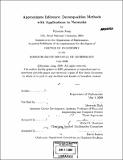| dc.contributor.advisor | Devavrat Shah. | en_US |
| dc.contributor.author | Jung, Kyomin | en_US |
| dc.contributor.other | Massachusetts Institute of Technology. Dept. of Mathematics. | en_US |
| dc.date.accessioned | 2010-01-07T20:58:25Z | |
| dc.date.available | 2010-01-07T20:58:25Z | |
| dc.date.copyright | 2009 | en_US |
| dc.date.issued | 2009 | en_US |
| dc.identifier.uri | http://hdl.handle.net/1721.1/50595 | |
| dc.description | Thesis (Ph. D.)--Massachusetts Institute of Technology, Dept. of Mathematics, 2009. | en_US |
| dc.description | Includes bibliographical references (p. 147-151). | en_US |
| dc.description.abstract | Markov random field (MRF) model provides an elegant probabilistic framework to formulate inter-dependency between a large number of random variables. In this thesis, we present a new approximation algorithm for computing Maximum a Posteriori (MAP) and the log-partition function for arbitrary positive pair-wise MRF defined on a graph G. Our algorithm is based on decomposition of G into appropriately chosen small components; then computing estimates locally in each of these components and then producing a good global solution. We show that if either G excludes some finite-sized graph as its minor (e.g. planar graph) and has a constant degree bound, or G is a polynoinially growing graph, then our algorithm produce solutions for both questions within arbitrary accuracy. The running time of the algorithm is linear on the number of nodes in G, with constant dependent on the accuracy. We apply our algorithm for MAP computation to the problem of learning the capacity region of wireless networks. We consider wireless networks of nodes placed in some geographic area in an arbitrary manner under interference constraints. We propose a polynomial time approximate algorithm to determine whether a, given vector of end-to-end rates between various source-destination pairs can be supported by the network through a combination of routing and scheduling decisions. Lastly, we investigate the problem of computing loss probabilities of routes in a stochastic loss network, which is equivalent to computing the partition function of the corresponding MR.F for the exact stationary distribution. | en_US |
| dc.description.abstract | (cont.) We show that the very popular Erlang approximation provide relatively poor performance estimates, especially for loss networks in the critically loaded regime. Then we propose a novel algorithm for estimating the stationary loss probabilities, which is shown to always converge, exponentially fast, to the asymptotically exact results. | en_US |
| dc.description.statementofresponsibility | by Kyomin Jung. | en_US |
| dc.format.extent | 151 p. | en_US |
| dc.language.iso | eng | en_US |
| dc.publisher | Massachusetts Institute of Technology | en_US |
| dc.rights | M.I.T. theses are protected by
copyright. They may be viewed from this source for any purpose, but
reproduction or distribution in any format is prohibited without written
permission. See provided URL for inquiries about permission. | en_US |
| dc.rights.uri | http://dspace.mit.edu/handle/1721.1/7582 | en_US |
| dc.subject | Mathematics. | en_US |
| dc.title | Approximate inference : decomposition methods with applications to networks | en_US |
| dc.type | Thesis | en_US |
| dc.description.degree | Ph.D. | en_US |
| dc.contributor.department | Massachusetts Institute of Technology. Department of Mathematics | |
| dc.identifier.oclc | 465220296 | en_US |
